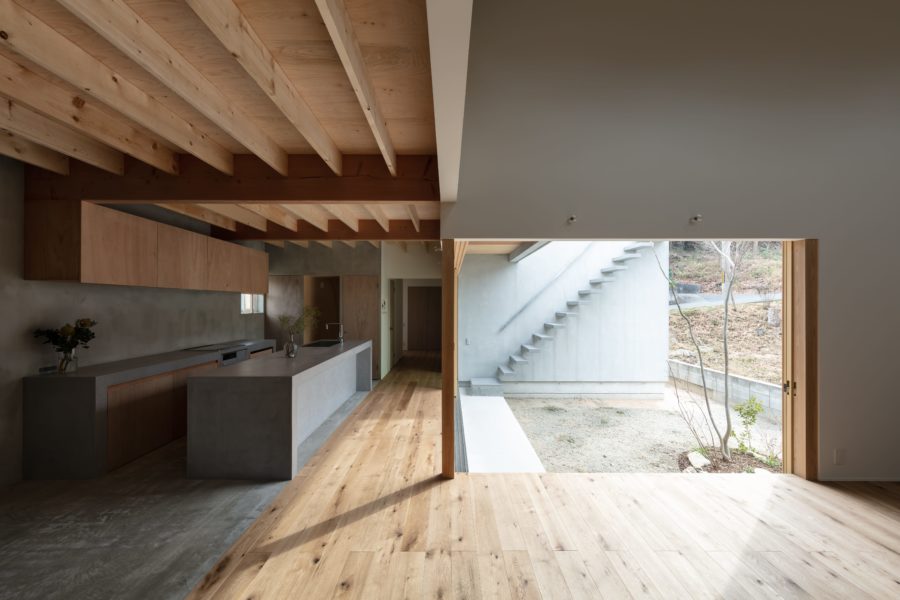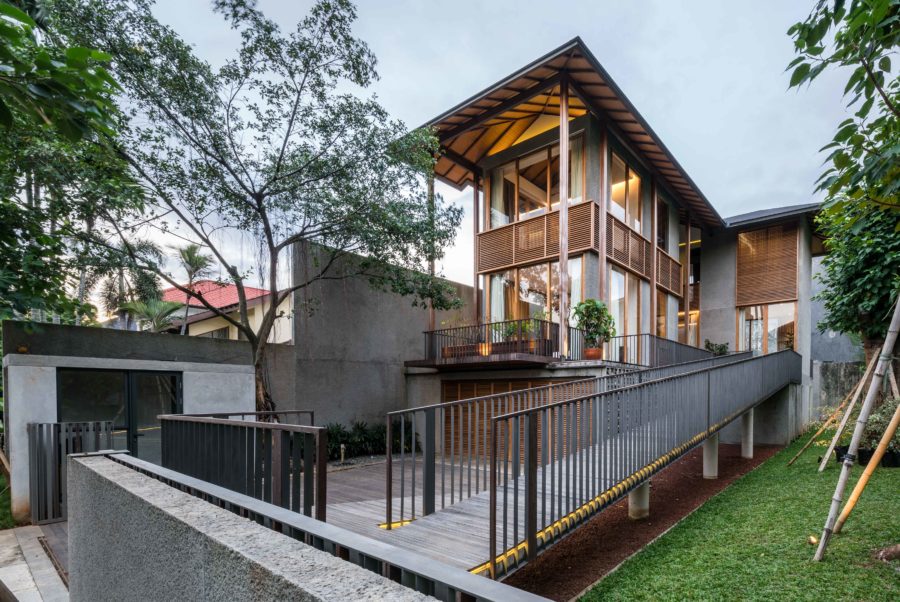奈良盆地の真ん中に位置する川西町は、1923年(大正12年)に橿原神宮へ参拝客を輸送する鉄道(大阪電気軌道、現在の近畿日本鉄道)が開通して発展を続けてきた。
結崎駅周辺もかつては中小の商業施設が集積していたが、今現在では新道路整備が進んで町外の大型商業施設への購買が流出し、結崎駅前の商業空洞化も顕著になっている。それでも、人口約8,000人の川西町に対して、結崎駅の乗車人員は約2,000人 / 日であり、車社会が進みながらも、川西町民にとって結崎駅は生活に欠かせない大切な存在である。
そこで駅前を盛り上げ、川西町が住みたい町、住み続けたい町となることを目指して、下記の3点に留意して、結崎駅前の機能再生が図られることになった。
①子ども・お年寄り・体が不自由な方でも徒歩・ベビーカー・車椅子での移動が安心な町であること
②結崎駅周辺を中心に、徒歩圏内に買い物・病院・学校・仕事など基本的な機能がすべて揃うこと
③町民・駅利用者同士が見える・見られる関係を創り出し、魅力的な公共空間で駅前のエリア価値を向上させること
2016年(平成28年)から住民巻き込み型ワークショップ「結崎駅フューチャーセッション」を実施し、小学生から幼稚園の保護者、お年寄りまでさまざまな世代・立場の川西町民にあまねく参加していただき、直接ヒアリングによるニーズ汲み取りを実施しながら、駅利用者・町民と行政(駅前再開発を推進する立場)との相互理解が進んだ。駅前広場・公園・駅舎の基本計画は、ここでの成果が基礎になっている。上述の結崎駅フューチャーセッションにより、橋上駅舎ではなく引き続き構内踏切による平面交差と東側にも新駅舎・改札を追加する計画とされ、東西それぞれに改札口が整備される(東口は未着工)。
西口は駅前広場・公園・ロータリーと接続道路の再整備により、下記の方針により北側に移転改築された。
①懐かしくも新しいモダンな駅舎にすること
②利用者・町民を暖かくお迎えする設えであること
③可能な限り天然素材を活用し、古墳時代からの歴史を重んじる空間であること
駅前に本物の古墳がある世界的にも珍しい駅で、駅改札口を出たら古墳と公園が目の前に広がる。駅改札口と交通機能を直結させる機能優先ではなく、結崎駅では世界に2つとない風景と記憶を優先させ、歩行者しか通行できない安全安心の公園を駅改札口に直結させている。
大和棟という奈良盆地では馴染み深い建築様式を手本に、鉄骨造の軽やかな屋根を構成してモダンに仕上げた。川西町の風景は、大和棟が連なる旧農村の集落と、昭和時代に急速に開発された集落とが混在している。残念ながら昭和時代の建築は長きに渡って調和の取れた町並みを構成しているとは言えず、スクラップ・アンド・ビルドが進む。古墳時代からの歴史がある川西町では、少なくとも江戸時代からの大和棟を手掛かりに、駅前で町民の記憶と歴史を紡いでゆくことが大事だと考えている。(川西康之)
The station building of the Yamato-mune weaves together the history and memory of the ancient burial mounds
Kawanishi Town, located in the center of the Nara Basin, had continued to develop since 1923 when a railroad (Osaka Electric Railway, now Kintetsu Railway) opened to transport visitors to the Kashihara Shrine.
The area around Yuzaki Station used to have a concentration of small and medium-sized commercial facilities. Still, now, with the construction of new roads, purchases have been diverted to large commercial facilities outside the town, and the commercial void in front of Yuzaki Station has become more pronounced. Even so, Yuzaki Station is still an essential part of the daily lives of Kawanishi residents, even though the town’s population of 8,000 is now approximately 2,000 passengers per day, and the car-oriented society is progressing.
Therefore, to enliven the area in front of the station and make Kawanishi a town where people want to live and continue to live, the following three points were taken into consideration in the functional revitalization of the area in front of Yuzaki Station.
(1) To be a town where children, the elderly, and the physically challenged can safely move around on foot, with strollers, or in wheelchairs.
(2) To have all basic functions such as shopping, hospitals, schools, and work within walking distance from the Yuzaki Station area.
(3) To create a relationship where town residents and station users can see and be seen by each other and to enhance the value of the area in front of the station with an attractive public space.
In 2016, we began holding the “Yuzaki Station Future Session,” a workshop involving local residents, in which a wide range of Kawanishi Town residents of various generations and positions, from elementary school students to kindergarten parents and senior citizens, participated. Mutual understanding between the station users/people and the administration (in charge of promoting the redevelopment in front of the station) was promoted. The basic plans for the station plaza, park, and station building are based on the results of this process. The Yuzaki Station Future Session described above resulted in a plan to add a new station building and ticket gates on the station’s east side and to continue building a level crossing with an on-premises railroad crossing instead of a bridge over the station.
The west exit was relocated and reconstructed on the north side according to the following policies by redeveloping the station square, park, roundabout, and connecting roads.
(1) To create a nostalgic yet new and modern station building
(2) To provide a warm welcome to users and residents of the town
(3) To use natural materials as much as possible and to respect the area’s history since the Kofun period.
The station is one of the few stations in the world with a real burial mound in front of the station, and the burial mound and park spread out before you as you exit the station ticket gate. Rather than prioritize functionality by directly connecting the station gates with transportation functions, Yuzaki Station prioritizes scenery and memories that cannot be found anywhere else in the world. It directly associates the station gates with a safe and secure park only accessible to pedestrians.
Taking a model from the Yamato-mune, an architectural style familiar in the Nara Basin, a light steel-framed roof was composed to create a modern look. The landscape of Kawanishi Town is a mixture of old farming villages with rows of Yamato-mune and villages that were rapidly developed in the Showa period. Unfortunately, Showa-era architecture has not constituted a harmonious townscape for a long time, and scrap-and-build is underway. In Kawanishi Town, which has a history dating back to the Kofun period, we believe it is essential to weave the memories and history of the townspeople in front of the station, using at least Yamato-mune from the Edo period as a clue. (Yasuyuki Kawanishi)
【結崎駅舎・駅前公園】
所在地:奈良県磯城郡川西町577
用途:駅・公衆トイレ・公園
クライアント:近畿日本鉄道、川西町
竣工:2022年
設計:イチバンセン
担当:川西康之、笹井夕莉、興津みなみ
構造設計:安藤耕作、藤田 啓(ANDO Imagineering Group)
共同設計:横畑勇記、政木千佳、田代かりん(全日本コンサルタント)
設計協力:柳 辰太郎(柳建築設計事務所)、小谷松雄次(Design Message)
設備:林田啓太、三苫紘子(全日本コンサルタント)
施工:大日本土木、中和コンストラクション
撮影:佐藤亮介(イチバンセン)
工事種別:新築
構造:鉄骨造
規模:地上1階
敷地面積:2683.34m²
建築面積:77.63m²
延床面積:26.36m²
設計期間:2020.01-2020.07
施工期間:2021.09-2022.06
【Yuzaki railway station】
Location: 577, Oaza Yuzaki, Kawanishi-cho, Shiki-gun, Nara, Japan
Principal use: Station, Toilet, Leisure facility
Client: Kintetsu Railway, Kawanishi-cho
Completion: 2022
Architects: Ichibansen
Design team: Yasuyuki Kawanishi, Yuri Sasai, Minami Okitsu
Structure engineer: ANDO Imagineering Group
Joint design: ALL NIPPON ENGINEERING CONSULTANTS
Design cooperation: YANAGI ARCHITECTS, Design Message
Equipment: ALL NIPPON ENGINEERING CONSULTANTS
Contractor: Dai Nippon Construction, CHUWA Construction
Photographs: Ryosuke Sato / Ichibansen
Construction type: New Building
Main structure: Steel
Building scale: 1story
Site area: 2683.34m²
Building area: 77.63m²
Total floor area: 26.36m²
Design term: 2020.01-2020.07
Construction term: 2021.09-2022.06








